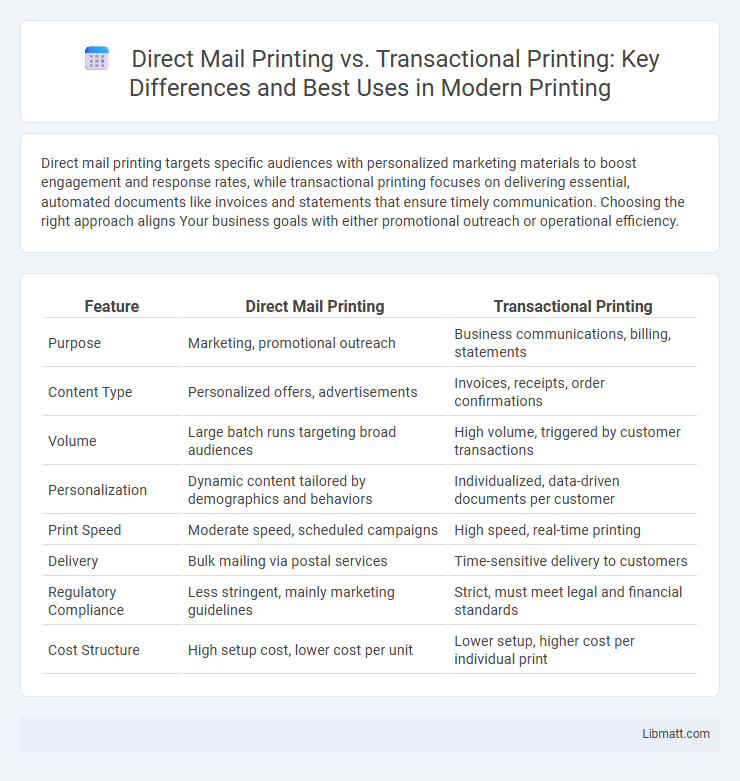Direct mail printing targets specific audiences with personalized marketing materials to boost engagement and response rates, while transactional printing focuses on delivering essential, automated documents like invoices and statements that ensure timely communication. Choosing the right approach aligns Your business goals with either promotional outreach or operational efficiency.
Table of Comparison
| Feature | Direct Mail Printing | Transactional Printing |
|---|---|---|
| Purpose | Marketing, promotional outreach | Business communications, billing, statements |
| Content Type | Personalized offers, advertisements | Invoices, receipts, order confirmations |
| Volume | Large batch runs targeting broad audiences | High volume, triggered by customer transactions |
| Personalization | Dynamic content tailored by demographics and behaviors | Individualized, data-driven documents per customer |
| Print Speed | Moderate speed, scheduled campaigns | High speed, real-time printing |
| Delivery | Bulk mailing via postal services | Time-sensitive delivery to customers |
| Regulatory Compliance | Less stringent, mainly marketing guidelines | Strict, must meet legal and financial standards |
| Cost Structure | High setup cost, lower cost per unit | Lower setup, higher cost per individual print |
Understanding Direct Mail Printing
Direct mail printing involves creating personalized marketing materials sent to targeted audiences to promote products, services, or events, emphasizing high-quality visuals and compelling messages. This method leverages demographic data to customize content, enhancing recipient engagement and response rates. Compared to transactional printing, which focuses on functional documents like invoices or statements, direct mail printing prioritizes brand awareness and customer acquisition through tailored design and strategic distribution.
What is Transactional Printing?
Transactional printing refers to the process of producing personalized documents such as invoices, statements, receipts, and notifications that contain critical information for individual recipients. This form of printing relies heavily on data-driven automation to ensure accuracy, security, and timely delivery, often integrated with digital systems for real-time updates. Your business benefits from transactional printing by enhancing customer communication through clear, compliant, and customized printed content.
Key Differences Between Direct Mail and Transactional Printing
Direct mail printing targets a broad audience with promotional content designed to drive customer engagement and brand awareness, featuring customizable marketing messages and vibrant graphics. Transactional printing, on the other hand, involves printing personalized documents such as invoices, statements, or bills that contain specific customer data and are essential for regulatory compliance and record-keeping. Understanding these key differences helps you optimize your communication strategy by choosing direct mail for marketing campaigns and transactional printing for accurate, timely delivery of critical customer information.
Purposes and Objectives: Marketing vs. Communication
Direct mail printing focuses on marketing purposes by delivering promotional materials designed to generate customer engagement and boost sales through targeted campaigns. Transactional printing serves communication objectives by producing essential documents such as invoices, statements, and receipts that provide customers with critical account information. Both types of printing utilize personalized content but differ in intent: direct mail drives consumer action while transactional printing ensures regulatory compliance and transparency.
Personalization in Direct Mail vs. Transactional Documents
Direct mail printing excels in personalization by allowing targeted marketing messages tailored to specific customer preferences, enhancing engagement and response rates. Transactional printing delivers personalized information such as invoices, statements, and receipts that are essential for individual account accuracy and customer communication. Your business benefits from leveraging direct mail for customized promotions while relying on transactional printing for precise, personalized documentation.
Design and Layout Considerations
Direct mail printing emphasizes vibrant, eye-catching designs with bold colors and personalized graphics to capture recipients' attention, often incorporating promotional messages and calls to action. Transactional printing prioritizes clarity and simplicity, featuring structured layouts with essential information like account details, statements, or receipts to ensure accuracy and readability. Your choice between the two should align with whether you need to engage customers visually or communicate critical data efficiently.
Data Management and Security Requirements
Direct mail printing involves managing large, diverse mailing lists requiring robust data segregation and frequent updates to ensure targeted campaigns, while transactional printing demands stringent data security measures due to sensitive customer information like invoices and statements. Your data management system must support real-time processing and encryption to protect personal details in transactional printing, whereas direct mail benefits from advanced segmentation and compliance with data privacy regulations. Both printing types require secure storage and controlled access to prevent data breaches and maintain customer trust.
Cost Analysis: Direct Mail vs. Transactional Printing
Direct mail printing often incurs higher costs due to customized designs, variable quantities, and postage expenses, while transactional printing benefits from standardized formats and bulk production efficiencies that reduce per-unit costs. Your business can optimize expenses by leveraging transactional printing's automated processes for routine documents like invoices and statements, whereas direct mail campaigns require careful budgeting for targeted outreach materials. Analyzing volume, customization needs, and delivery timelines is essential to determine the most cost-effective printing option.
Compliance and Regulatory Considerations
Direct mail printing must adhere to strict marketing and privacy regulations, including CAN-SPAM and GDPR, requiring clear opt-in consent and accurate data handling to avoid legal penalties. Transactional printing involves sensitive customer information such as billing or account statements, demanding compliance with financial regulations like HIPAA or PCI-DSS to ensure data security and confidentiality. Both printing types necessitate rigorous compliance frameworks to protect consumer data and maintain regulatory standards, with transactional printing often facing more stringent requirements due to the nature of the content.
Choosing the Best Printing Solution for Your Business
Direct mail printing targets marketing campaigns with customized, visually engaging materials designed to drive customer response, while transactional printing focuses on producing essential documents like invoices, statements, and receipts with high accuracy and security. Selecting the optimal printing solution depends on business goals: direct mail printing enhances brand visibility and customer engagement, whereas transactional printing ensures regulatory compliance and seamless operational communication. Analyze volume, personalization needs, and cost-efficiency to determine whether direct mail or transactional printing aligns best with your business objectives.
Direct mail printing vs transactional printing Infographic

 libmatt.com
libmatt.com